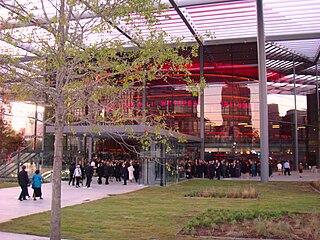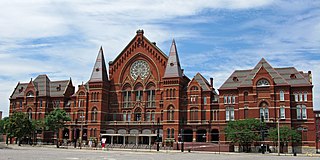The Opera Society of Washington

Washington National Opera was established in 1957 as the Opera Society of Washington by Day Thorpe, the music critic of the now defunct Washington Star, but then the most influential Washington newspaper of its day. Paul Callaway, the choirmaster and organist of the Washington National Cathedral, was its first music director. Together, the two set out to seek funding and they found support from Gregory and Peggy Smith who provided $10,000 as seed money for a production of Mozart's Die Entführung aus dem Serail which would be performed following the end of their summer season (which Calloway conducted) by the Washington Symphony Orchestra.
Characteristic of Thorpe and Callaway's early years was a rejection of cuts to the scores, a rejection of opera in English translation, and a rejection of expensive scenery as well as of "fat sopranos" and "self-centered tenors". [2]
The pair set out to seek a new public and, beginning with the first production of Die Entführung on 31 January 1957, the company presented opera in George Washington University's Lisner Auditorium, albeit a small venue with limited facilities. [3] However, as one critic noted: "There was no 'company' in the literal sense. Each production had to be conceived, planned, and arranged individually, and financial support had to be scraped up opera by opera. Improvisation was the order of the day". [4]
The early years, 1956 to 1966
Four months later, the Society staged a double bill of Gian Carlo Menotti's opera The Old Maid and the Thief along with his ballet The Unicorn, The Gorgon, and the Manticore. It was very successful with both the public and critics alike. Successful presentations followed from November 1957 onwards: Fidelio ; Ariadne auf Naxos ; Idomeneo ; a double bill of Schoenberg's Erwartung and Stravinsky's Le Rossignol (conducted by the composer); and a December 1961 The Magic Flute which resulted in an invitation from President John F. Kennedy at the White House for some excerpts from the opera.

By this time, the attention of the national press had been caught. A December 1958 Newsweek full-page article on the company was headlined "Sparkle on the Potomac", and Howard Taubman of the New York Times visited regularly, followed by headlines reading "Capital Revival" and "Sparkle on the Potomac" [5]
However, there was not always such clear sailing, and the company was to experience a series of ups and downs in the first few years of the 1960s. Initially, there was further success: bringing Igor Stravinsky to Washington was the work of Bliss Herbert, then the Artistic Administrator of the Santa Fe Opera who had been involved in that company's early years when the composer regularly visited Santa Fe. However, the first Stravinsky production – The Rake's Progress – was "the most "ill-starred" opera in the Society's history", [6] largely the result of singers' illnesses. But a later double bill of Stravinsky conducting Le Rossignol (along with Schoenberg's Erwartung ) was a triumph.
However, as the 1960s progressed, further disasters were to follow. These included "a fiasco of unforgivable proportions", [7] an English-language The Magic Flute which caused Paul Callaway's resignation. Some drastic measures were called for.
Changes in direction, 1966 to 1977
Three new faces were to bring "imagination and flair to the company" [8] during the period up to 1977 and, by that date, another new face made a short but dramatic appearance in the company's history: bass-baritone George London became general manager.
Taking over as general manager in 1967 was Richard Pearlman, under whose tenure were staged well-received productions of The Turn of the Screw , La bohème , and the first production of Barber's Vanessa . By 1972 Ian Strasfogel, with considerable experience from working at the Metropolitan Opera, took over the helm with the aim of giving it a "businesslike foundation" [9] "it never had in its sixteen years, in spite of the excellent productions it has often achieved". [10]

One early success was a production of Kurt Weill's Rise and Fall of the City of Mahagonny with the composer's widow, Lotte Lenya, in attendance. She described it as "the best production she has ever seen". [9] Other significant productions followed, but, in summing up Strasfogel's success, author Mary Jane Phillips-Matz concludes that "his main achievement, though, was his artistic oversight, for by the mid-1970s critics were regularly covering the Opera Society's extraordinary programming and grants were coming in from important foundations." [9]
During this period of the 1970s another person was to enter the scene, stage director Frank Rizzo. There followed a stunning Madama Butterfly and other important productions and his association with the company continued into the 1980s with his introduction in 1984 of the Canadian Opera Company's surtitles system, whereby an English translation appeared above the proscenium arch. [9]
Also while under Strasfogel's tenure, the Opera Society made its move into the newly opened Kennedy Center for the Performing Arts in 1972. This was to have a profound impact on the company, especially since George London, after retirement from the stage, became Artistic Administrator at the Kennedy Center until its 1971 opening and then Executive Director of the Nation Opera Institute. He directed a production of Die Walküre for the opera company in 1974 and was courted to become General Director for the 1977 season.












